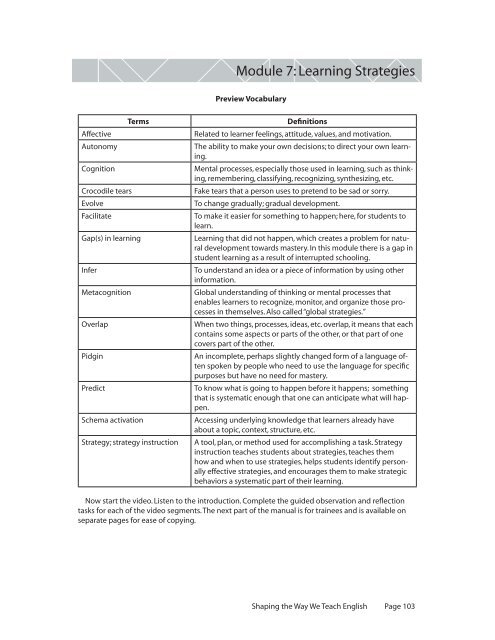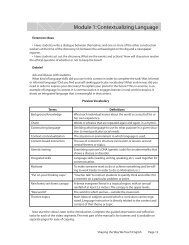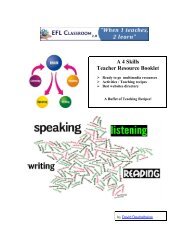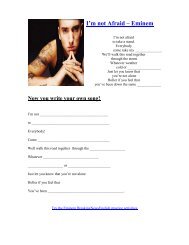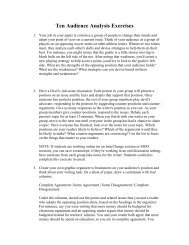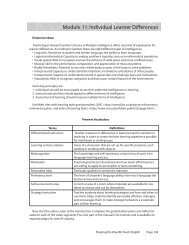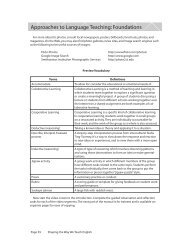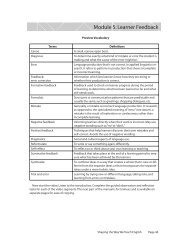Module 7: Learning Strategies - EFL Classroom 2.0
Module 7: Learning Strategies - EFL Classroom 2.0
Module 7: Learning Strategies - EFL Classroom 2.0
Create successful ePaper yourself
Turn your PDF publications into a flip-book with our unique Google optimized e-Paper software.
<strong>Module</strong> 7: <strong>Learning</strong> <strong>Strategies</strong><br />
Preview Vocabulary<br />
Terms<br />
Affective<br />
Autonomy<br />
Cognition<br />
Crocodile tears<br />
Evolve<br />
Facilitate<br />
Gap(s) in learning<br />
Infer<br />
Metacognition<br />
Overlap<br />
Pidgin<br />
Predict<br />
Schema activation<br />
Strategy; strategy instruction<br />
Definitions<br />
Related to learner feelings, attitude, values, and motivation.<br />
The ability to make your own decisions; to direct your own learning.<br />
Mental processes, especially those used in learning, such as thinking,<br />
remembering, classifying, recognizing, synthesizing, etc.<br />
Fake tears that a person uses to pretend to be sad or sorry.<br />
To change gradually; gradual development.<br />
To make it easier for something to happen; here, for students to<br />
learn.<br />
<strong>Learning</strong> that did not happen, which creates a problem for natural<br />
development towards mastery. In this module there is a gap in<br />
student learning as a result of interrupted schooling.<br />
To understand an idea or a piece of information by using other<br />
information.<br />
Global understanding of thinking or mental processes that<br />
enables learners to recognize, monitor, and organize those processes<br />
in themselves. Also called “global strategies.”<br />
When two things, processes, ideas, etc. overlap, it means that each<br />
contains some aspects or parts of the other, or that part of one<br />
covers part of the other.<br />
An incomplete, perhaps slightly changed form of a language often<br />
spoken by people who need to use the language for specific<br />
purposes but have no need for mastery.<br />
To know what is going to happen before it happens; something<br />
that is systematic enough that one can anticipate what will happen.<br />
Accessing underlying knowledge that learners already have<br />
about a topic, context, structure, etc.<br />
A tool, plan, or method used for accomplishing a task. Strategy<br />
instruction teaches students about strategies, teaches them<br />
how and when to use strategies, helps students identify personally<br />
effective strategies, and encourages them to make strategic<br />
behaviors a systematic part of their learning.<br />
Now start the video. Listen to the introduction. Complete the guided observation and reflection<br />
tasks for each of the video segments. The next part of the manual is for trainees and is available on<br />
separate pages for ease of copying.<br />
Shaping the Way We Teach English Page 103
Approaches to Language Teaching: Extension<br />
Introduction, Expanded Narrative<br />
<strong>Module</strong> 7, <strong>Learning</strong> <strong>Strategies</strong><br />
The strategies described in Readings A and B below are only some examples of possible strategies.<br />
A strategy might be a teaching strategy in one classroom context and a learning strategy in another.<br />
As strategies are mostly “invisible” mental processes, you will need to analyze what you see and hear,<br />
and in some cases, infer what strategies may be at work in the tasks that follow.<br />
<strong>Module</strong> Focus<br />
The focus of this module is on:<br />
• Language learning and communication strategies.<br />
• Metacognitive and cognitive strategies.<br />
Students can become better learners if they are able to use learning strategies. Good language<br />
learners develop their own set of these strategies. In second language acquisition literature, strategies<br />
carry different definitions and fall into a variety of categories. Some common concepts are:<br />
• <strong>Learning</strong> or academic strategies.<br />
• Metacognitive and cognitive strategies.<br />
• Social and affective strategies.<br />
The teacher’s role is to consciously build strategy training into the lessons to help students develop<br />
their own strategies. First, teachers need to learn about their students’ backgrounds, identify student<br />
problems, and find out what strategies learners are currently using. They can do this through observation,<br />
by informally talking with the students, interviewing them, or having formal consultations.<br />
They then need to help students figure out which strategies might work best for them. A students<br />
become more adept at identifying and applying strategies for themselves, they become better selfteachers.<br />
Video Segment #1, Observation Guide: Watch, Analyze, Infer<br />
[Read before viewing.]<br />
Viewing Task A<br />
At the beginning of the video, you will hear and see a list a characteristics and strategies that are<br />
shared by successful language learners. While listening, try to make notes on as many of them as you<br />
can recall. Check with others and compare your lists, adding them as needed. Can you agree on a<br />
definition for “success” in your learners?<br />
This module takes an in-depth look at a single classroom case. Here are some additional things to<br />
look for in this module.<br />
• Types of strategies in the classroom.<br />
• Language-specific skills.<br />
• Affective factors.<br />
Viewing Task B<br />
1. Review the content in Readings A and B for this module. Note that teaching and learning strategies<br />
are closely related. What strategies do the articles describe? As you watch the video, make note<br />
Page 104<br />
Shaping the Way We Teach English
<strong>Module</strong> 7: <strong>Learning</strong> <strong>Strategies</strong><br />
of any strategies from the readings that you see or hear the teacher talks about in the video.<br />
2. View the video again. List the language-specific skills that students use in the class and the<br />
activities that students are doing. Note which skills are used during each activity and how they are<br />
integrated. What strategies might be at work?<br />
3. View the tape a third time and try to list affective factors, both those that the teacher planned<br />
or used and those that seem part of the class dynamic. What strategies might be at work from this<br />
perspective?<br />
Reflection<br />
[Read and answer after viewing.]<br />
For this section, compare your notes with those of others in your group for items 1-3 from the previous<br />
Viewing Task B section for this module. Discuss what was the same or different and why. Use the<br />
following reflection questions as a discussion guide.<br />
1. How would you categorize most of the strategies that you observed (whether directly or<br />
through inference)? Were they teaching or learning strategies, or some combination of both? When is<br />
learning “self-teaching” in a strategies context? Which specific strategies do you think the students in<br />
this class are utilizing as they do the activities? One thing the teacher talked about was the challenges<br />
her students had. What were some of these challenges and how did they affect learning? What<br />
kinds of challenges do your own students face?<br />
2. Compare notes on language-specific skills and activities. How are the skills integrated in the<br />
activities? What strategies does the teacher model or use to help students focus on important points<br />
and understand content? Do you use any of these? If so, which ones, and how do you use them?<br />
3. What affective factors were present in the organization of the classroom space? In the lesson<br />
format and way the teacher had students do the work? Do you think they were effective? Explain<br />
your answer to others in your group.<br />
Summary Discussion<br />
1. Take out the list you wrote as part of the Before Viewing (schema activation) activity about your<br />
own language learning experiences. Also take your list of successful learner characteristics and<br />
strategies from the previous Viewing Task A activity. Compare them. Which of the items are the same?<br />
Which are different? What gaps do you see? Do you think these items provide a good description of a<br />
successful language learner? Would you add anything? Subtract anything?<br />
2. Referring back to the various notes you created during this module, consider the following:<br />
• Are you aware of the kinds of strategies your own students use? What are the ones you see<br />
used most frequently? Are some of your students more “successful language learners” than others?<br />
Explain.<br />
• Are there any of the strategies from this module that you consider to be more important in a<br />
classroom than others? Explain.<br />
3. After viewing this module, do you think you will try to use some of these strategies in your class?<br />
Why or why not? If yes, which ones will you try? Which ones do you think might be most successful<br />
with your particular students? How will you go about diagnosing students and introducing strategies<br />
in the classroom? You can use this information for the next section, Now You Try It—An Action Plan.<br />
Shaping the Way We Teach English Page 105
Approaches to Language Teaching: Extension<br />
Now You Try It—An Action Plan<br />
Step 1<br />
You can read some of the articles on the topic of learning strategies (see <strong>Module</strong> 7 Readings A and<br />
B plus the List of Additional Readings and Resources below). Using the video, you have seen a few<br />
examples and ideas from other teachers’ classes.<br />
Now, think about your own classes and your answers to the summary questions above. How could<br />
you use some of the strategies and techniques listed to accomplish or improve on work you have<br />
already done with the following items?<br />
• Create a trusting classroom atmosphere that encourages risk-taking and participation.<br />
• Build student confidence in their ability to use the language.<br />
• Improve learners’ cognitive processing.<br />
• Activate schema.<br />
• Help students transfer their skills to appropriate language use in your situation, perhaps for content<br />
classes that are taught in English, for Internet accessibility, for understanding music and movies,<br />
or for talking with foreigners.<br />
Talk about your ideas with a partner or with your group.<br />
Step 2<br />
By yourself or with a partner, design a portion of a lesson that includes the use of some of the<br />
strategies you listed.<br />
Step 3<br />
Share your plan with others. Explain what activity would come before and after your segment. Get<br />
peer ideas and feedback.<br />
Step 4<br />
Change your design, as needed. Try it with your class. If you are not teaching, ask the trainer or<br />
another experienced teacher for feedback.<br />
Note<br />
You may have noticed a variety of posters, wall and bulletin board displays in the video for this and<br />
other modules. Written reminders for learning strategies and other classroom information can help<br />
students with the learning process. Some teachers purchase such items, but many teachers (and even<br />
students!) make them from inexpensive or recycled materials as well. For ideas, see the following.<br />
How to Make a Great Poster<br />
Author: Dina F. Mandoli, University of Washington, Department of Botany<br />
Web site: http://www.aspb.org/education/poster.cfm<br />
ProTeacher! Bulletin Board Ideas<br />
Web site: http://www.proteacher.com/030004.shtml<br />
Teacher Helpers, Bulletin Board Ideas<br />
Author: Kathy Schrock<br />
Web site: http://school.discovery.com/schrockguide/bulletin/<br />
Page 106<br />
Shaping the Way We Teach English
<strong>Module</strong> 7: <strong>Learning</strong> <strong>Strategies</strong><br />
<strong>Module</strong> 7 Reading A, ERIC EC Digest #E638: Strategy Instruction<br />
Author: Pat Beckman<br />
This article is in the Public Domain. Reprinted in its original text format. Retrieved January 21, 2006,<br />
from the Web site: http://hoagiesgifted.org/eric/e638.html<br />
Overview<br />
For more than two decades there has been an abundance of research regarding strategy instruction.<br />
Originally, most of this research focused on the effects of strategy instruction on students with<br />
learning disabilities. Researchers are currently looking at how strategy instruction affects all learners.<br />
What is a strategy?<br />
In general, a strategy is a tool, plan, or method used for accomplishing a task. Below are other terms<br />
associated with strategy instruction, some of which are discussed in this digest:<br />
• Cognitive Strategy: a strategy or group of strategies or procedures that the learner uses to perform<br />
academic tasks or to improve social skills. Often, more than one cognitive strategy is used with<br />
others, depending on the learner and his / her schema for learning. In fact, research indicates that<br />
successful learners use numerous strategies. Some of these strategies include visualization, verbalization,<br />
making associations, chunking, questioning, scanning, underlining, accessing cues, using<br />
mnemonics, sounding out words, and self-checking and monitoring.<br />
• Cues: visual or verbal prompts to either remind the student what has already been learned or<br />
provide an opportunity to learn something new. Cues can also be employed to prompt student use<br />
of a strategy.<br />
• Independent, Strategic Learner: the student who uses cues and strategies within his / her learning<br />
schema, asks clarifying questions, listens, checks and monitors his / her work and behavior, and<br />
sets personal goals. A strategic learner knows the value of using particular strategies through experience,<br />
and is eager to learn others that might prove beneficial.<br />
• <strong>Learning</strong> Strategy: a set of steps to accomplish a particular task, such as taking a test, comprehending<br />
text, and writing a story. A first-letter mnemonic is often used to help the learner follow the<br />
steps of the strategy.<br />
• Metacognition and Self-regulation: the understanding a person has about how s/he learns (personal<br />
learning schema) including the strategies used to accomplish tasks, and the process by which<br />
the learner oversees and monitors his / her use of strategies.<br />
• Mnemonic: a device for remembering, such as a first-letter mnemonic for writing: PLAN (Pay attention<br />
to the prompt, List main ideas, Add supporting ideas, Number your ideas) (DeLaPaz, Owen,<br />
Harris and Graham, 2000). Rhyme, rhythm, music, and key-word mnemonics are also useful memory<br />
tools.<br />
• Strategy Instruction: teaching students about strategies, teaching them how and when to use<br />
strategies, helping students identify personally effective strategies, and encouraging them to make<br />
strategic behaviors part of their learning schema.<br />
• <strong>Learning</strong> Schema: the sets, or mixes, of strategies that the individual learner uses automatically to<br />
perform, produce, communicate, or learn. It can take years to develop a personal learning schema.<br />
What has been learned about the effectiveness of strategy instruction?<br />
Many students’ ability to learn has been increased through the deliberate teaching of cognitive<br />
and metacognitive strategies. This is especially true for students with significant learning problems-<br />
Shaping the Way We Teach English Page 107
Approaches to Language Teaching: Extension<br />
strategy instruction is crucial for them. It has been demonstrated that when struggling students are<br />
taught strategies and are given ample encouragement, feedback, and opportunities to use them,<br />
students improve in their ability to process information, which, in turn, leads to improved learning.<br />
Because not all students will find it easy to imbed strategy use in their learning schema, differentiation<br />
of strategies instruction is required, with some students needing more scaffolding and individualized,<br />
intensive instruction than others.<br />
Why is it important to teach children to be strategic?<br />
The Individuals with Disabilities Education Act (IDEA) of 1997 and the No Child Left Behind (NCLB)<br />
Act of 2001 focus on improved achievement by all students. IDEA mandates that all students access<br />
and progress in the general education curriculum. This includes students with disabilities, English<br />
language learners, and gifted students. NCLB has established performance goals that drive the efforts<br />
of public schools, especially in establishing proficiency in reading / language arts and mathematics<br />
by all students by the year 2013-2014. The outcomes listed below help ensure student progress.<br />
Additionally, when students become strategic, independent learners, they also become literate and<br />
productive lifelong learners.<br />
What happens to students when they become strategic?<br />
The following outcomes can be expected:<br />
• Students trust their minds.<br />
• Students know there’s more than one right way to do things.<br />
• They acknowledge their mistakes and try to rectify them.<br />
• They evaluate their products and behavior.<br />
• Memories are enhanced.<br />
• <strong>Learning</strong> increases.<br />
• Self-esteem increases.<br />
• Students feel a sense of power.<br />
• Students become more responsible.<br />
• Work completion and accuracy improve.<br />
• Students develop and use a personal study process.<br />
• They know how to “try.”<br />
• On-task time increases; students are more “engaged.”<br />
What are the most essential strategies to teach?<br />
This is determined, in large part, by assessing what successful, efficient learners do. It has been<br />
found that they use numerous strategies across subjects and tasks, such as those listed above under<br />
“cognitive strategies”. They know when to use strategies and for what purposes. An attempt to identify<br />
the most essential strategies students should learn is an impossible task; it depends on the needs<br />
of the learner and the requirements of the curriculum. However, student use of the following strategies<br />
often leads to improved student performance (lists are not inclusive):<br />
• Computation and problem-solving: Verbalization, visualization, chunking, making associations,<br />
use of cues.<br />
• Memory: Visualization, verbalization, mnemonics, making associations, chunking, and writing.<br />
These are usually more effective when used in combinations.<br />
• Productivity: Verbalization, self-monitoring, visualization, use of cues.<br />
• Reading accuracy and fluency: Finger pointing or tracking, sounding out unknown words, self-<br />
Page 108<br />
Shaping the Way We Teach English
<strong>Module</strong> 7: <strong>Learning</strong> <strong>Strategies</strong><br />
questioning for accuracy, chunking, and using contextual clues.<br />
• Reading comprehension: Visualization, questioning, rereading, predicting.<br />
• Writing: Planning, revising, questioning, use of cues, verbalization, visualization, checking and<br />
monitoring. How are students taught to use strategies? Effective strategy instruction is an integral<br />
part of classroom instruction, regardless of the content being taught; it is not an additional subject.<br />
In the transactional strategies instruction (TSI) model, strategies instruction takes place all year long<br />
with the teacher giving explanations and modeling. Teachers continually praise students for using<br />
strategies and use teachable moments to discuss them. Students are encouraged to help their peers<br />
become more strategic.<br />
What are the basic steps in teaching strategy use?<br />
The following order of steps should be followed:<br />
• Describe the strategy. Students obtain an understanding of the strategy and its purpose-why it is<br />
important, when it can be used, and how to use it.<br />
• Model its use. The teacher models the strategy, explaining to the students how to perform it.<br />
• Provide ample assisted practice time. The teacher monitors, provides cues, and gives feedback.<br />
Practice results in automaticity so the student doesn’t have to “think” about using the strategy.<br />
• Promote student self-monitoring and evaluation of personal strategy use. Students will likely use<br />
the strategy if they see how it works for them; it will become part of their learning schema.<br />
• Encourage continued use and generalization of the strategy. Students are encouraged to try the<br />
strategy in other learning situations.<br />
To what extent is strategy instruction taking place in classrooms?<br />
Currently, there are little data available to determine how many teachers teach strategic learning<br />
skills, how many are even aware of their existence, or if they are aware, have the skills to teach them.<br />
Few teachers demonstrate to their students their own personal strategy use. In general, teachers<br />
are not aware of the importance of these skills. The fact that there is such little data leads to the assumption<br />
that strategy instruction is not a general classroom practice. Following are a few possible<br />
explanations for this:<br />
• Early strategy instruction research was done specifically with learning disabled populations.<br />
General education preservice and inservice programs have not generalized these research findings<br />
to all learners.<br />
• How students learn takes a back seat to what is learned. Teachers assume students will “get it” on<br />
their own, or with more teacher-directed instruction or practice.<br />
• The idea of focusing on the learner is still in its infancy.<br />
• “Educator overload” is a factor. Teachers, experiencing the pressures of accountability for student<br />
progress, feel they don’t have time to “learn one more thing,” especially something they are not convinced<br />
will improve student learning.<br />
Numerous researchers are assisting educators in turning strategies research into practice. An increasing<br />
number of strategies instruction curricula are available, especially in reading and writing.<br />
Resources<br />
Beckman, P. & Weller, C. (1990). Active, independent learning for children with learning disabilities.<br />
TEACHING Exceptional Children, 21/22, 26-29.<br />
Shaping the Way We Teach English Page 109
Approaches to Language Teaching: Extension<br />
Cornford, I.R. (2002, 7 December). <strong>Learning</strong>-to-learn skills for lifelong learning: Some implications for<br />
curriculum development and teacher education. Paper presented at the AARE annual conference,<br />
Sydney.<br />
De La Paz, S. (1999). Self-regulated strategy instruction in regular education settings: Improving<br />
outcomes for students with and without learning disabilities. <strong>Learning</strong> Disabilities Research and<br />
Practice, 14, 92-118.<br />
De La Paz, S., Owen, B., Harris, K. & Graham, S. (2000). Riding Elvis’ Motorcycle: Using self-regulated<br />
strategy development to PLAN and WRITE for a state writing exam. <strong>Learning</strong> Disabilities Research &<br />
Practice, 15, 101-109.<br />
Deshler, D.D., Schumaker, J.B., Lenz, B.K., Bulgren, J.A., Hock, M.F., Knight, J., & Ehren, B J. (2001). Ensuring<br />
content-area learning by secondary students with learning disabilities. <strong>Learning</strong> Disabilities<br />
Research & Practice, 16, 96-108.<br />
Hamman, D. (1998). Preservice teachers’ value for learning-strategy instruction. Journal of Experimental<br />
Education, 66, 209-222.<br />
Harris, K.R. & Graham, S. (1996). Making the writing process work: <strong>Strategies</strong> for composition and selfregulation.<br />
Cambridge: MA: Brookline Books.<br />
Keene, E.O. & Zimmermann, S. (1997). Mosaic of thought. Portsmouth, NH: Heinemann.<br />
Logan, J.W., Olson, M.W., & Lindsey, T.P. (1993). Lessons from champion spellers. Journal for the Education<br />
of the Gifted, 13, 89-96.<br />
Meichenbaum, D. & Biemiller, A. (1998). Nurturing independent learners. Cambridge, MA: Brookline<br />
Books.<br />
Pressley, M. & Woloshyn, V. (1995). Cognitive strategy instruction that really improves children’s academic<br />
performance. Cambridge, MA: Brookline Books.<br />
<strong>Module</strong> 7 Reading B,<br />
Strategy Training for Second Language Learners, Eric Digest EDO-FL-03-02<br />
Author: Andrew Cohen<br />
This article is in the Public Domain. Reprinted in its original text format. Retrieved January 21, 2006,<br />
from the Web site: http://www.cal.org/ericcll/digest/0302cohen.html<br />
Overview<br />
Students of foreign language are being encouraged to learn and use a broad range of language<br />
learning strategies that can be tapped throughout the learning process. This approach is based on<br />
the belief that learning will be facilitated by making students aware of the range of strategies from<br />
which they can choose during language learning and use. The most efficient way to heighten learner<br />
awareness is to provide strategy training—explicit instruction in how to apply language learning<br />
strategies—as part of the foreign language curriculum. This digest discusses the goals of strategy<br />
training, highlights approaches to such training, and lists steps for designing strategy training<br />
Page 110<br />
Shaping the Way We Teach English
<strong>Module</strong> 7: <strong>Learning</strong> <strong>Strategies</strong><br />
programs.<br />
Goals of Strategy Training<br />
Strategy training aims to provide learners with the tools to do the following:<br />
• Self-diagnose their strengths and weaknesses in language learning.<br />
• Become aware of what helps them to learn the target language most efficiently.<br />
• Develop a broad range of problem-solving skills.<br />
• Experiment with familiar and unfamiliar learning strategies.<br />
• Make decisions about how to approach a language task.<br />
• Monitor and self-evaluate their performance.<br />
• Transfer successful strategies to new learning contexts.<br />
<strong>Strategies</strong> can be categorized as either language learning or language use strategies. Language<br />
learning strategies are conscious thoughts and behaviors used by learners with the explicit goal of<br />
improving their knowledge and understanding of a target language. They include cognitive strategies<br />
for memorizing and manipulating target language structures, metacognitive strategies for<br />
managing and supervising strategy use, affective strategies for gauging emotional reactions to learning<br />
and for lowering anxieties, and social strategies for enhancing learning, such as cooperating with<br />
other learners and seeking to interact with native speakers.<br />
Language use strategies come into play once the language material is already accessible, even in<br />
some preliminary form. Their focus is to help students utilize the language they have already learned.<br />
Language use strategies include strategies for retrieving information about the language already<br />
stored in memory, rehearsing target language structures, and communicating in the language despite<br />
gaps in target language knowledge.<br />
Frameworks for Strategy Training<br />
Although no empirical evidence has yet been provided to determine a single best method for<br />
conducting strategy training, at least three different instructional frameworks have been identified.<br />
Each has been designed to raise student awareness of the purpose and rationale of strategy use, give<br />
students opportunities to practice the strategies they are being taught, and help them use the strategies<br />
in new learning contexts.<br />
One framework, proposed by Pearson and Dole (1987) with reference to first language learning<br />
but applicable to the study of a second language as well, targets isolated strategies by including<br />
explicit modeling and explanation of the benefits of applying a specific strategy, extensive functional<br />
practice with the strategy, and an opportunity to transfer the strategy to new learning contexts. The<br />
sequence includes the following steps:<br />
• Initial modeling of the strategy by the teacher, with direct explanation of the strategy’s use and<br />
importance.<br />
• Guided practice with the strategy.<br />
• Consolidation, where teachers help students identify the strategy and decide when it might be<br />
used.<br />
• Independent practice with the strategy.<br />
• Application of the strategy to new tasks.<br />
In the second framework , Oxford et al. (1990) outline a useful sequence for the introduction of<br />
strategies that emphasizes explicit strategy awareness, discussion of the benefits of strategy use,<br />
Shaping the Way We Teach English Page 111
Approaches to Language Teaching: Extension<br />
functional and contextualized practice with the strategies, self-evaluation and monitoring of language<br />
performance, and suggestions for or demonstrations of the transferability of the strategies to<br />
new tasks. This sequence is not prescriptive of strategies that the learners are supposed to use, but<br />
rather descriptive of the various strategies that they could use for a broad range of learning tasks.<br />
The third framework, developed by Chamot and O’Malley (1994), is especially useful after students<br />
have already had practice in applying a broad range of strategies in a variety of contexts. Their<br />
approach to helping students complete language learning tasks can be described as a four-stage<br />
problem-solving process.<br />
(1) Planning. Students plan ways to approach a learning task.<br />
(2) Monitoring. Students self-monitor their performance by paying attention to their strategy use<br />
and checking comprehension.<br />
(3) Problem Solving. Students find solutions to problems they encounter.<br />
(4) Evaluation. Students learn to evaluate the effectiveness of a given strategy after it has been applied<br />
to a learning task.<br />
Options for Providing Strategy Training<br />
A variety of instructional models for foreign language strategy training have already been developed<br />
and implemented in a variety of educational settings. Seven of these are described below.<br />
General Study Skills Courses. These courses are sometimes intended for students with academic<br />
difficulties but can also target successful students who want to improve their study habits. Many<br />
general academic skills can be transferred to the process of learning a foreign language, such as using<br />
flash cards, overcoming anxiety, and learning good note-taking skills. These courses sometimes<br />
include language learning as a specific topic to highlight how learning a foreign language may differ<br />
from learning other academic subjects. Foreign language students can be encouraged to participate<br />
in order to develop general learning strategies.<br />
Awareness Training. Lectures and Discussion. Also known as consciousness-raising or familiarization<br />
training, this consists most often of isolated lectures and discussions and is usually separate<br />
from regular classroom instruction. This approach provides students with a general introduction to<br />
strategy applications. Oxford (1990) describes awareness training as “a program in which participants<br />
become aware of and familiar with the general idea of language learning strategies and the way such<br />
strategies can help them accomplish various language tasks” (p. 202).<br />
Strategy Workshops. Short workshops are another, usually more intensive, approach to increasing<br />
learner awareness of strategies through various consciousness-raising and strategy-assessment activities.<br />
They may help to improve specific language skills or present ideas for learning certain aspects<br />
of a particular foreign language. These workshops may be offered as non-credit courses or required<br />
as part of a language or academic skills course. They often combine lectures, hands-on practice with<br />
specific strategies, and discussions about the effectiveness of strategy use.<br />
Peer Tutoring. “Tandem” or peer tutoring programs began in the 1970s in Europe and are flourishing<br />
in many universities across the United States. Holec (1988) describes this system as “a direct language<br />
exchange” program that pairs students of different native language backgrounds for mutual<br />
tutoring sessions (e.g., an English-speaking student studying Italian and a native-Italian-speaking<br />
student learning English). Requirements of the tutoring sessions are that students have regular meetings,<br />
alternate roles of learner and teacher, practice the two languages separately, and devote equal<br />
Page 112<br />
Shaping the Way We Teach English
<strong>Module</strong> 7: <strong>Learning</strong> <strong>Strategies</strong><br />
amounts of time to each language. Often, students exchange suggestions about the language learning<br />
strategies they use, thus providing an ad hoc form of strategy training.<br />
Another approach to peer sessions is to encourage students who are studying the same language<br />
to organize regular target-language study groups. Students who have already completed the language<br />
course may also be invited to these meetings. Less proficient students can benefit from the<br />
language skills of more proficient students, and more proficient students may yield better insights<br />
into the particular difficulties of the target language than a teacher.<br />
<strong>Strategies</strong> in Language Textbooks. Many foreign language textbooks have begun to embed strategies<br />
into their curricula. However, unless the strategies are explained, modeled, or reinforced by the<br />
classroom teacher, students may not be aware that they are using strategies at all. A few language<br />
textbooks provide strategy-embedded activities and explicit explanations of the benefits and applications<br />
of the strategies they address. Because the focus of the activities is contextualized language<br />
learning, learners can develop their learning strategy repertoires while learning the target language.<br />
One advantage of using textbooks with explicit strategy training is that students do not need extracurricular<br />
training; the textbooks reinforce strategy use across both tasks and skills, encouraging<br />
students to continue applying them on their own.<br />
Videotaped Mini-Courses. Rubin (1996) developed an interactive videodisc program and accompanying<br />
instructional guide aimed at raising students’ awareness of learning strategies and of the learning<br />
process in general, to show students how to transfer strategies to new tasks and to help them<br />
take charge of their own progress while learning the language. Using authentic language situations,<br />
the instructional program includes 20 foreign languages and offers the opportunity to select the<br />
language, topic, and difficulty level. Materials are structured to expose students to various strategies<br />
for use in many different contexts.<br />
<strong>Strategies</strong>-Based Instruction (SBI). SBI is a learner-centered approach to teaching that extends<br />
classroom strategy training to include both implicit and explicit integration of strategies into the<br />
course content. Students experience the advantages of systematically applying the strategies to<br />
the learning and use of the language they are studying. In addition, they have opportunities to<br />
share their preferred strategies with other students and to increase their strategy use in the typical<br />
language tasks they are asked to perform. Teachers can individualize strategy training, suggest<br />
language-specific strategies, and reinforce strategies while presenting the regular course content. In<br />
a typical SBI classroom, teachers do the following:<br />
• Describe, model, and give examples of potentially useful strategies<br />
• Elicit additional examples from students, based on students’ own learning experiences<br />
• Lead small-group and whole-class discussions about strategies<br />
• Encourage students to experiment with a broad range of strategies<br />
• Integrate strategies into everyday class materials, explicitly and implicitly embedding them into<br />
the language tasks to provide for contextualized strategy practice<br />
Teachers may conduct SBI instruction by starting with established course materials, then determining<br />
which strategies to insert and where; starting with a set of strategies they wish to focus on and<br />
design activities around them; or inserting strategies spontaneously into the lessons whenever it<br />
seems appropriate (e.g., to help students overcome problems with difficult material or to speed up<br />
the lesson).<br />
Steps for Designing Strategy Training<br />
The approaches outlined above offer options for providing strategy training to a large number of<br />
Shaping the Way We Teach English Page 113
Approaches to Language Teaching: Extension<br />
learners. Based on the needs, resources, and time available to an institution, the next step is to plan<br />
the instruction students will receive. The following seven steps are based largely on suggestions of<br />
strategy training by Oxford (1990). The model is especially useful because it can be adapted to the<br />
needs of various groups of learners, the resources available, and the length of the strategy training.<br />
See Cohen (1998) for a thorough description of these steps.<br />
1. Determine learners’ needs and the resources available for training.<br />
2. Select the strategies to be taught.<br />
3. Consider the benefits of integrated strategy training.<br />
4. Consider motivational issues.<br />
5. Prepare the materials and activities.<br />
6. Conduct explicit strategy training.<br />
7. Evaluate and revise the strategy training.<br />
Conclusion<br />
The guidelines for implementing strategy training programs provide a variety of options for<br />
tailoring the training to meet the needs of a large number of students, as well as to the needs of the<br />
individual institution or language program. The most important considerations in the design of a<br />
strategy training program are the students’ needs, the available resources ( e.g., time, money, materials,<br />
availability of teacher trainers), and the feasibility of providing this kind of instruction.<br />
When including strategies-based instruction in a foreign language curriculum, it is important to<br />
choose an instructional model that introduces the strategies to the students and raises awareness of<br />
their learning preferences; teaches them to identify, practice, evaluate, and transfer strategies to new<br />
learning situations; and promotes learner autonomy to enable students to continue their learning<br />
after they leave the language classroom.<br />
Note<br />
The information in this digest was drawn from chapter 4 of Cohen (1998).<br />
References<br />
Chamot, A. U., & O’Malley, J. M. (1994). The CALLA handbook: Implementing the cognitive academic<br />
language learning approach. Reading, MA: Addison-Wesley.<br />
Cohen, A. D. (1998). <strong>Strategies</strong> in learning and using a second language. New York: Longman.<br />
Holec, H. (1988). Autonomy and self-directed learning: Present fields of application. Project no. 12:<br />
<strong>Learning</strong> and teaching modern languages for communication. Strasbourg, France: Council for<br />
Cultural Co-operation.<br />
Oxford, R. (1990). Language learning strategies: What every teacher should know. New York: Newbury/<br />
Harper Collins.<br />
Oxford, R. L., Crookall, D., Cohen, A., Lavine, R., Nyikos, M., & Sutter, W. (1990). Strategy training for language<br />
learners: Six situational case studies and a training model. Foreign Language Annals, 22(3),<br />
197-216.<br />
Page 114<br />
Shaping the Way We Teach English
<strong>Module</strong> 7: <strong>Learning</strong> <strong>Strategies</strong><br />
Pearson, P. D., & Dole, J. A. (1987). Explicit comprehension instruction: A review of research and a new<br />
conceptualization of learning. Elementary School Journal, 88, 151-65.<br />
Rubin, J. (1996). Using multimedia for learner strategy instruction. In Oxford, R. L. (Ed.), Language learning<br />
strategies around the world: Cross-cultural perspectives (pp. 151-56). Honolulu: University of<br />
Hawai’i, Second Language Teaching & Curriculum Center.<br />
Shaping the Way We Teach English Page 115
Approaches to Language Teaching: Extension<br />
List of Additional Readings and Resources<br />
Anderson, N. J. (2002). The role of metacognition in second language teaching and learning. ERIC<br />
Digest EDO-FL-01-10. Retrieved September 29, 2005, from http://www.cal.org/ericcll/digest/<br />
0110anderson.html<br />
Autonomous learning modules, for listening. (2003a). Retrieved September 29, 2005, from Helsinki University,<br />
Language Centre. http://www.helsinki.fi/kksc/alms/listen.html<br />
Beckman, P. (2002). Strategy instruction. ERIC Digest ED47430. Retrieved September 29, 2005, from<br />
http://hoagiesgifted.org/eric/e638.html<br />
Boston, C. (2003). Cognitive science and assessment. ERIC Digest ED481716. Retrieved September 29,<br />
2005, from http://eric.ed.gov/ERICWebPortal/contentdelivery/servlet/ERICServlet?accno=ED48171<br />
6<br />
Cohen, A. (2003). Strategy training for second language learners. ERIC Digest EDO-FL-03-02. Retrieved<br />
September 29, 2005, from http://www.cal.org/ericcll/digest/0302cohen.html<br />
Conversation strategies. (2005). Retrieved September 29, 2005, from University of British Columbia,<br />
English Language Institute Web site: http://learningresources.eli.ubc.ca/speakingandlistening/<br />
200sl/conversation_strategies.html<br />
Crandall, J., Jaramillo, A., Olsen, L., & Peyton, J. K. (2002). Using cognitive strategies to develop English<br />
language and literacy. ERIC Digest EDO-FL-02-05. Retrieved September 29, 2005, from http://www.<br />
cal.org/ericcll/digest/0205crandall.html<br />
Davis, D. (1998). Reading strategies: What do good readers do? What can you do to become a better<br />
reader? Panhandle Area Educational Consortium, Florida Instructional Technology Training Resource<br />
Unit. Retrieved September 29, 2005, from http://www.paec.org/david/reading/general.pdf<br />
Huron, D. (2002). Listening styles and listening strategies. Retrieved September 29, 2005, from<br />
Ohio State University, Music Cognition Web site: http://dactyl.som.ohio-state.edu/Huron/Talks/<br />
SMT.2002/handout.html<br />
Keys to better listening. (1998). Retrieved September 29, 2005, from Hong Kong Polytechnic University,<br />
English Language Centre Web site: http://elc.polyu.edu.hk/elsc/material/Listening/kListening.htm<br />
Oxford, R. (1994). Language learning strategies: An update. ERIC Digest. Retrieved September 29, 2005,<br />
from http://www.cal.org/ericcll/digest/oxford01.html<br />
Writing: Instructional philosophy and teaching suggestions. (n.d.). Evergreen Curriculum Guides &<br />
Resources, Saskatchewan, Canada. Retrieved September 29, 2005, from http://www.sasked.gov.<br />
sk.ca/docs/mla/write.html<br />
Page 116<br />
Shaping the Way We Teach English


